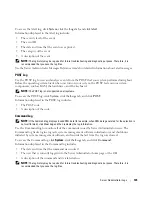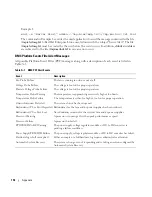
Glossary
133
Glossary
The following list defines or identifies technical
terms, abbreviations, and acronyms used in your
system documents.
A
Abbreviation for ampere(s).
AC
Abbreviation for alternating current.
AC power switch
A switch with two AC power inputs that provides
AC power redundancy by failing over to a standby
AC input in the event of a failure to the primary AC input.
access
Refers to the actions a user can take on a variable value.
Examples include read-only and read-write.
ACL
Abbreviation for access control list. ACL files are text
files that contain lists that define who can access
resources stored on a Novell
®
Web server.
adapter card
An expansion card that plugs into an expansion-card
connector on the system's system board. An adapter
card adds some specialized function to the system by
providing an interface between the expansion bus and
a peripheral device. Examples of adapter cards include
network cards, sound cards, and SCSI adapters.
ADB
Abbreviation for assign database.
AGP
Abbreviation for advanced graphics port.
ASCII
Acronym for American Standard Code for Information
Interchange. A text file containing only characters from
the ASCII character set (usually created with a text
editor, such as Notepad in Microsoft
®
Windows
®
), is
called an ASCII file.
ASIC
Acronym for application-specific integrated circuit.
ASPI
Acronym for advanced SCSI programming interface.
asset tag code
An individual code assigned to a system, usually by a
system administrator, for security or tracking purposes.
attribute
An attribute, or property, contains a specific piece of
information about a manageable component.
Attributes can be combined to form groups. If an
attribute is defined as read-write, it may be defined by
a management application.
autoexec.bat file
The
autoexec.bat
file is executed when you boot your
system (after executing any commands in the
config.sys
file). This start-up file contains commands
that define the characteristics of each device connected
to your system, and it finds and executes programs
stored in locations other than the active directory.
backup
A copy of a program or data file. As a precaution, you
should back up your system's hard drive on a regular
basis. Before making a change to the configuration of
your system, you should back up important start-up
files from your operating system.
Summary of Contents for External OEMR 850
Page 14: ...14 Introduction ...
Page 16: ...16 What s New for Version 2 3 ...
Page 44: ...44 Using Server Administrator ...
Page 54: ...54 Installing Server Administrator ...
Page 88: ...88 Working With the Baseboard Management Controller BMC ...
Page 102: ...102 Remote Access Service ...
Page 126: ...126 Diagnostic Service ...
Page 130: ...130 Server Administrator Logs ...
















































